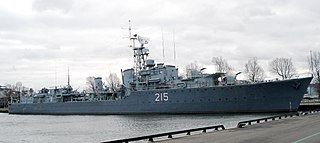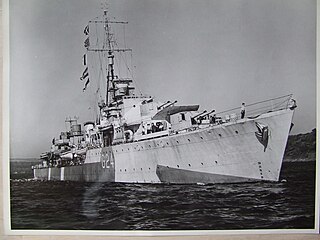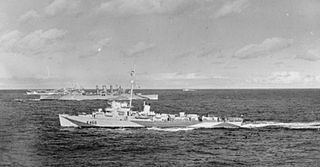Related Research Articles

HMS Egret was a sloop of the British Royal Navy, the lead ship of her class. She was built by J. Samuel White at Cowes, Isle of Wight, was launched on 31 May 1938, and entered service on 11 November that year. Egret served as a convoy escort with the Western Approaches Command from 1940 until her loss in August 1943: She was on anti-submarine patrol in the Bay of Biscay when she was sunk by a guided missile in combat, the first ship to be lost in this manner.

HMCS Haida is a Tribal-class destroyer that served in the Royal Canadian Navy (RCN) from 1943 to 1963, participating in World War II and the Korean War. She was named for the Haida people.

The HX convoys were a series of North Atlantic convoys which ran during the Battle of the Atlantic in the Second World War. They were east-bound convoys and originated in Halifax, Nova Scotia from where they sailed to ports in the United Kingdom. They absorbed the BHX convoys from Bermuda en route. Later, after the United States entered the war, HX convoys began at New York.

The C and D class was a group of 14 destroyers built for the Royal Navy in the early 1930s. As in previous years, it was originally intended to order a complete flotilla comprising eight destroyers—plus a flotilla leader as the ninth unit—in each year. However, only four ships—plus a leader—were ordered under the 1929–1930 Programme as the C class. The other four ships planned for the C class were never ordered as an economy measure and disarmament gesture by the Labour government of Ramsay MacDonald. A complete flotilla—the 'D' class—was ordered under the 1930–1931 Programme.

The Flower-class corvette was a British class of 294 corvettes used during World War II, specifically with the Allied navies as anti-submarine convoy escorts during the Battle of the Atlantic. Royal Navy ships of this class were named after flowers, hence the name of the class.
The first USS McCook (DD-252) was a Clemson-class destroyer in the United States Navy. Entering service in 1919, the ship had a brief active life before being placed in the reserve fleet. Reactivated for World War II, the ship was transferred to the Royal Navy and then to the Royal Canadian Navy and renamed HMCS St. Croix. Assigned as a convoy escort in the Battle of the Atlantic, St. Croix was torpedoed and sunk on 20 September 1943.
Four Canadian naval units have been named HMCS Ottawa.

HMCS Alberni was a Flower-class corvette that served in the Royal Canadian Navy (RCN) during the Second World War. The Flower-class corvettes were warships designed for anti-submarine warfare. The ship was constructed by Yarrows Ltd. in Esquimalt, British Columbia, laid down on 19 April 1940, launched on 22 August and commissioned on 4 February 1941. The corvette sailed east to join the RCN's fleet in the Atlantic via the Panama Canal, where upon arrival, the vessel began escorting trans-atlantic convoys in the Battle of the Atlantic. Arvida took part in the key convoy battle of Convoy SC 42. In 1942, the corvette was transferred to Allied convoy assignments associated with Operation Torch in the Mediterranean Sea. In 1944, Arvida was among the Canadian naval vessels assigned to Operation Neptune, the naval component of the invasion of Normandy and escorted support ships to and from the United Kingdom on D-day.
Rear Admiral Robert Walter Timbrell, CMM, DSC, CD, Royal Canadian Navy was the first Canadian to be decorated with the Distinguished Service Cross during the Second World War. This followed his part in Operation Dynamo where he was personally responsible for the evacuation of 900 troops from the beaches of Dunkirk.

HMCS Huron was a Tribal-class destroyer that served in the Royal Canadian Navy in the Second World War and the Korean War. She was the first ship to bear this name, entering service in 1943. She was named for the Huron people. During the Second World War the vessel saw service in Operation Neptune in the Bay of Biscay and along the French coast in support of the invasion of Normandy and escorted convoys to the Soviet Union. Following the war, the ship was placed in reserve. The destroyer was activated in 1950 as a training ship, but with the onset of the Korean War, was modernized and deployed twice to Korea. Following the war, Huron reverted to a training ship and took part in Cold War-era North Atlantic Treaty Organization (NATO) naval exercises until being paid off for the final time in 1963 and broken up for scrap in 1965.
Several Canadian naval units have been named HMCS Chaudiere.

HMS Bickerton was a Captain-class frigate of the Royal Navy. She served during the World War II as a convoy escort and anti-submarine warfare vessel in the Battle of the Atlantic and was an effective U-boat killer, being credited with the destruction of two U-boats during a service career of just 10 months. Bickerton was lost in action on 22 August 1944.

HMS Decoy was a D-class destroyer of the Royal Navy. Ordered in 1931, the ship was constructed by John I. Thornycroft & Company, and entered naval service in 1933. Decoy was initially assigned to the Mediterranean Fleet before she was transferred to the China Station in early 1935. She was temporarily deployed in the Red Sea during late 1935 during the Abyssinia Crisis, before returning to her duty station where she remained until mid-1939. Decoy was transferred back to the Mediterranean Fleet just before the Second World War began in September 1939. She briefly was assigned to West Africa for convoy escort duties in 1940 before returning to the Mediterranean. The ship participated in the Battles of Calabria without significant damage and escorted ships of the Mediterranean Fleet for most of the rest of the year.

Vice Admiral Henry George "Harry" DeWolf was a Canadian naval officer who was famous as the first commander of HMCS Haida during the Second World War.
HMCS Qu'Appelle can refer to several different things named after the Qu'Appelle River in Saskatchewan:
Several Canadian naval units have been named HMCS Restigouche.
Several Canadian naval units have been named HMCS Gatineau.
Several Canadian naval units have been named HMCS Skeena.

The River class was a class of fourteen destroyers of the Royal Canadian Navy (RCN) that served before and during the Second World War. They were named after Canadian rivers.

HMS Cygnet was a C-class destroyer built for the Royal Navy in the early 1930s. The ship was initially assigned to the Home Fleet, although she was temporarily deployed in the Red Sea during the Abyssinia Crisis of 1935–36. Cygnet was sold to the Royal Canadian Navy (RCN) in late 1937 and renamed HMCS St. Laurent. She was stationed on the west coast of Canada when World War II began in September 1939, and had to be transferred to the Atlantic coast for convoy escort duties. She served as a convoy escort in the Battle of the Atlantic and participated in the sinking of two German submarines. The ship was on anti-submarine patrols during the invasion of Normandy, and was employed as a troop transport after VE Day for returning Canadian servicemen. St. Laurent was decommissioned in late 1945 and scrapped in 1947.